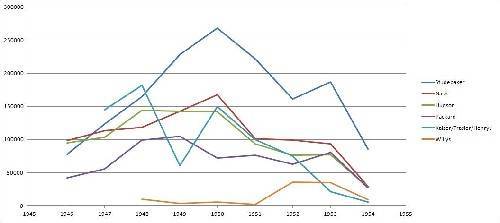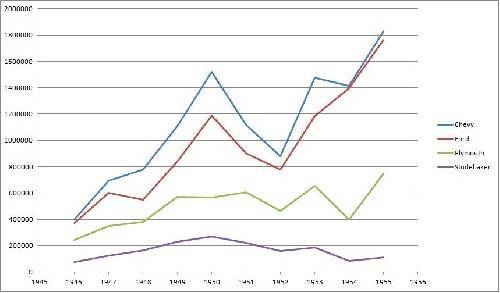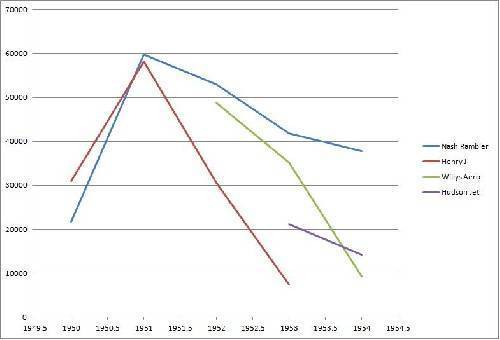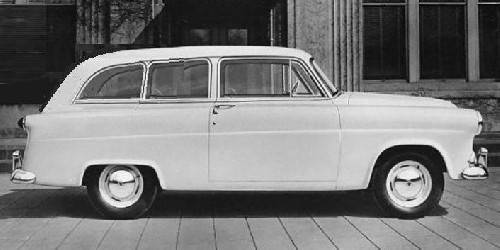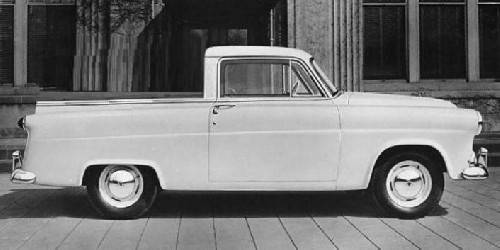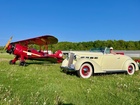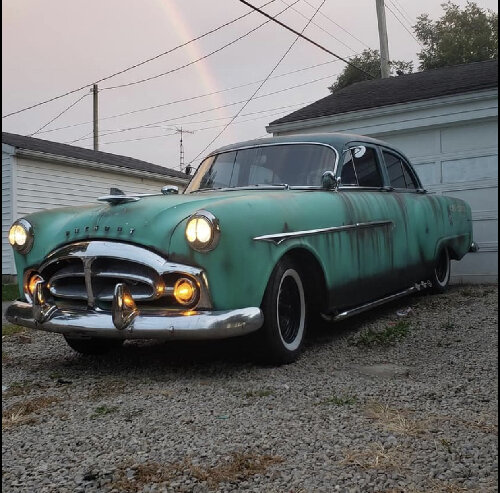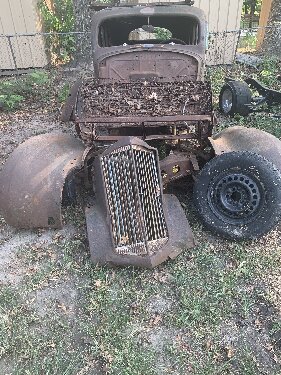|
Re: Packard & Hudson proximity
|
||||
|---|---|---|---|---|
|
Home away from home

|
Hi
You're absolutely right, idea was correct, the venue and execution were the problems. A few more years of production stability even in a deteriorating EGB while a new single-story facility was appended to Utica was far preferable to Connor Avenue. Addendum to my earlier post: Whether Studebaker: This might seem harsh coming from a Studebaker enthusiast, but until that corporation had rectified the myriad operations problems plaguing it by the early '50's, no merger should have been undertaken with them. While none of the companies had modern, efficient plants, South Bend was still operating in multi-story building that had at one time housed wooden conestoga wagons and horse harness production (the remaining of which can still be seen during a South Bend visit now). Pile on top of this out-of-control labor costs because management wanted to maintain it's "friendliest auto factory in the business" and inter-generational workforce stability reputation even while an uncompetitive labor situation developed. But much of what had made that reputation had been disrupted during the war years by cost-plus contracts and legions of new-hires; still rather than take on union strikes while fighting out wage parity with other automakers, management capitulated to most all of labor's demands. This is why shortly after the S-P merger, JJN's blood drained from his face when Walter Grant (Packard's chief financial officer) returned from South Bend to tell him that Studebaker's actual breakeven point was 282,000 units as opposed to the 165,000 they had claimed. The management team of Paul Hoffman and Harold Vance had been in place since 1933 and frankly were either tired or had become out of touch with developing industry trends, perhaps both. Dependence on Raymond Loewy Associates began with their 1936 contract, resultant 1938 Commanders and President and highly successful 1939 Champion. Prior to that Jimmy Hughes and the body engineering department created their styling, did a pretty credible job of it. For the most part, the RLA staff delivered marketable, even progressive, designs. To understand the Loewy contract, one has to know that Loewy himself did none of the designwork, was the overall director/promoter of an enterprise that developed the nascent industrial design business covering a wide range of industries. He hired some of the best talent available at the time including Virgil Exner, Bob Bourke, Clare Hodgman, Holden Koto, Vince Gardner and Gordon Beuhrig and dozens others . By the time of the S-P merger, following is illuminating, from Studebaker: The Postwar Years by Richard M. Langworth "The Loewy contract ran out in early 1955," Bob Bourke says. "And Studebaker-Packard's new management decided not to renew it." The decision was partly made because Nance had built up his own house styling team at Packard, and partly because the Loewy contract was incredibly expensive. "Our billings were about a million a year" Bourke recalls. "This included a lot of woodworkers and clay modelers too. Loewy marked up everything. Salaries were marked up one hundred percent. I want to be very clear about this - it was entirely customary to mark up that much. But at the time I think it was the largest single industrial design account, and it was very expensive for Studebaker." As head of the Loewy team at the time, Bob Bourke had a unique perspective on the internal working of that business relationship, is the most credible source we can to rely on now. Bourke was hired in 1941 and served through the majority of the contract. While he wasn't directly involved with the initial '39 Champion development he was instrumental in the 1947 line still under Exner for the most part. Exner would depart for Chrysler shortly as the '47's were introduced after a split with Loewy. But a bit of background first: From '39 to '42, Studebaker fielded two completely separate sized lines of cars. Their full-sized Commanders and President were featured and priced having the Commanders compete against low-medium makes such as Pontiac, Dodge, Mercury, Hudson Sixes, Nash Lafayette all the way through Buick Super, Chrysler Windsor, Packard 120, Hudson Commodore Eight and Nash Ambassador Eight opposite their President Eight. The Champion was approximately an 8/10 scale of the Ford/Chevy/Plymouth then considered the full-sized standard. It was price neared the top of their range but promoted for it's economy, durability and other good basic qualities. It was something of a harbinger of the Nash Rambler a decade later and found a receptive market. Commanders/Presidents were one body series and the Champions were completely separate up to '46. As the postwar planning begun with the war winding to a close, management decided all their new cars would share one body series based off the Champion architecture as it was their dominant volume line. Loewy loved this as he was now pushing his "Weight is the Enemy" mantra, with European-sized cars in mind for Americans. Raymond did not notice that many Americans regarded Europeans less respectfully having just had to fight and sacrifice to save their collective derrieres from total Nazi domination. Small, light and economical also equated to the deprivation of the Depression and war rationing years, something Americans had had enough of for most of a generation. Middle-class incomes had grown exponentially since 1940 and Americans were in an highly optimistic attitude. A narrow, light economy car was not what the majority had on their minds when they trekked to dealers in search of new wheels. But management forged ahead regardless and while the Champion did well in the seller's market, when demand became sated, it was time to seek the size and power they'd desired all along, then the Champion faded as the years moved on. Unfortunately, their Commander was also saddled with the narrow, light-car look and feel as well. Both also sold for a 10-12% price premium when compared to low and low-medium competitiors. Other than loyal Studebaker buyers, customers went elsewhere in search of better value. Shortly before and even while the 1953 models were in development, Studebaker experienced it's best sales years, 1950 being the peak, seemed to be vindication of their approach. Taking that tact, the '53 were again all new, keeping the Loewy ethic of scaled-down, narrow track and body width in force, resulting in probably the lightest body and frame structure at the time......it went many steps too far! The '53's quickly got a reputation for flimsy bodies and 'rubber' frames which was largely justified. The ladder frames, other than the front engine/suspension cradles were not boxed, just open channel, and only cross-members, no X-member. Even the prior series had had more solid structures under them. They had to begin correcting those problems immediately, the frame was strengthened for '55. The cowl design resulted in fender builds creating the infamous, moist-trap problem that showed itself shortly once in daily use. As to whether the stamping were poorly stored or not may be true, but in an effort to save money on materials, areas of the body were either only primer painted or were completely left unprotected with any paint. Looking up under the dash of my '57 President Classic all I saw was surface rusted bare metal high in the cowl! The floor stamping simply folded down and had the rockers panels attached with no full-length boxing behind them. State-of-the-art rust-proofing was an asphalt coating that could and did trap moisture once it hardened and split. Like most cars, here were no wheel-encircling inner fenders to keep the debris from attacking vulnerable areas. Mechanically, they remained the generally robust power trains they always had been. The one thing management really got right was fielding a ohv V-8 and automatic transmission early enough to keep them in the game. But, here's the irony of the horribly mismanaged 1953 line: after the consolidation to one body for 1947-52, none of the body stamping were shared between the sedans and the low hardtop and coupe bodies! So, whatever cost-effective savings that could have been achieved, they blundered ahead, paid for two complete sets of tooling to produce a styling triumph and a shorter, taller, dumpier version of the same design. They had in affect returned to a two-tier body program with the appealing hardtops and coupes making the sedans look like frumpy step-sisters by comparison! This is what Packard bought in 1954 to partner with as the objective of a fourth full-line car company. Even as much as Nash and Hudson had problems, they begin to pale by comparison what was had in South Bend! Your Comments? Steve
Posted on: 2013/2/20 13:17
|
|||
|
||||
|
Re: Packard & Hudson proximity
|
||||
|---|---|---|---|---|
|
Home away from home

|
Great summary Steve. Good grief, why would anyone have wanted to touch that? V8 was heavy too. The company did have name value, a dealer network and sales history that Nance and the Board would have studied carefully. 1954 numbers would have been coming in throughout the decision year.
Posted on: 2013/2/20 17:43
|
|||
|
||||
|
Re: Packard & Hudson proximity
|
||||
|---|---|---|---|---|
|
Home away from home

|
Quick thought about a still tall and narrow Packard competing with a raft of lower and wider '57s. All buyers except pre-'55 Hudson owners would have been trading cars of similar dimensions as the new Packard. Assuming the new Packard had a gorgeous new style, would these shoppers want a lower car or prefer the more comfortable seat height that they were used to? Some may have preferred to say the course just as Lincoln gained buyers from Cadillac in 1977-79.
Posted on: 2013/2/20 19:10
|
|||
|
||||
|
Re: Packard & Hudson proximity
|
||||
|---|---|---|---|---|
|
Home away from home

|
Need a chart with Ford and Chevrolet/GM as supposedly they were forcing "floor plans" onto dealers, whereas independents were still on an order basis. Chrysler had the notorious "sales bank" which provided stock at fire sale prices. It makes no sense that the splash oil Chevy should do so well, except that dealers were unloading them at slightly above cost.
Posted on: 2013/2/20 22:22
|
|||
|
||||
|
Re: Packard & Hudson proximity
|
||||
|---|---|---|---|---|
|
Home away from home

|
Hi
Chuckle!!!! chuckle!!!! "Good grief, why would anyone have wanted to touch that? " Good one, Paul! Probably on many sleepless nights the next couple years, Nance kept asking himself that very same question over and over! Whatever assets Studebaker brought to the table, hidden under the table was a pile of troublesome baggage. JJN and company should have looked there before it slipped any ring on South Bend's finger! Steve
Posted on: 2013/2/21 8:38
|
|||
|
||||
|
Re: Packard & Hudson proximity
|
||||
|---|---|---|---|---|
|
Home away from home

|
Absolutely. Looking deeper into the sales it is pretty clear that without the Loewy coupes (46% of Studebaker's total volume in '53, 34% in '54), Studebaker would have had a rather poor 1953 despite a brand new design. Was suprised by this. The strong showing of the coupes, which Nance would have known by summer of 1953 when Barit came to visit, also suggests that Hudson had an opportunity with the Jet platform for a 2+2 version of a cleaned up Italia, priced around $2100.
Noticed one other thing in the sales numbers. While Hudson generally lagged Ambassador and Packard 200/Clipper through 1953, in 1954 it beat them both, all with a simple freshening program of a 7 year old design. Imagine what a complete redesign of the step-down could have done for both Hudson and Packard. 1954 Sales: Hornet - 24,833 Ambassador - 21,428 Clipper - 23,073 As requested, here is a chart of the low-priced field.
Posted on: 2013/2/21 15:50
|
|||
|
||||
|
Re: Packard & Hudson proximity
|
||||
|---|---|---|---|---|
|
Home away from home

|
Sales data for compacts in these years.
Wagon version of Rambler represented about 1/3 of total Rambler production. Jet should have fielded one too. Well, check that. Jet as it came to be should have never been. But since it did, the plump stubby body may have lent itself better to a 2-box profile. Also a pick-up. Nance would have had a tough 1954 with Hudson dragging him down. But if he could have survived it, 1955 could have been a 150,000 year. And to help 1954 the Hornet could have gotten the 327 Eight and ultramatic. The Jet utility pick-up probably could have been quickly tooled as well.
Posted on: 2013/2/21 16:14
|
|||
|
||||
|
Re: Packard & Hudson proximity
|
||||
|---|---|---|---|---|
|
Home away from home

|
Sorry Guys, I sometimes get in exploration mode and need to chase these things down. Here's a step-down unibody Panther with rear axle/decklid moved rearward 5 inches, front axle moved forward 2 inches for new wheelbase of 134 (assuming Panther sat on Cavalier's 127). Unibody would be retained by incorporating fixed B-pillar that would be hidden by chrome-framed windows when closed. Windshield frame would look like a convertible version but have structure behind the chrome. Moving steering wheel forward 5 inches allows rear legroom to be same as Patrician.
UPDATE: made a mistake, it was the rear overhang that I had increased 5 inches, not the rear axle location. Also decided to go back to the original hood length. Wheelbase is once again 127 inches; have updated the image to reflect. Greenhouse appears to be siimilar length to Patrician. Would have been a very roadable car with 352 V8 underhood, torsion level below. Hudson would get the 320, shorter hood, possibly shorter rear overhang, unique door outers and differently trimmed greenhouse. All cars would have similar height and width to the GM C-bodies that came out in 1957 and could have sold with great success through 1958 with only a freshening at mid-cycle. The money Packard spent on the '55 program would have gone a long way towards paying for this alternative strategy. Attach file:  (15.31 KB) (15.31 KB)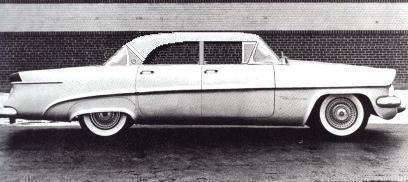
Posted on: 2013/2/21 20:18
|
|||
|
||||
|
Re: Packard & Hudson proximity
|
||||
|---|---|---|---|---|
|
Home away from home

|
Comparing the previous image to an early 50s Hudson coupe it appears that the Hudson body length from firewall to rear axle is fairly similar and the cowl height is the same, which means Hudson's firewall might have been carried over and possibly its floor stamping provided both were wide enough for the wider Panther body. This may well have been the case given that Panther was built on a Packard frame and chassis of similar width as Hudson. Trunk floor stamping would have needed to be newly tooled, the Hudson's being much shorter. The big change would been with the frame around the rear wheels, Hudson's track needing to be widened significantly.
After checking various sources it appears that Hudson may have stamped and welded its own bodies for its large step-downs contrary to what James Ward suggested in his book. Hudson did rely on Murray to stamp and build its Jet bodies and Murray actually paid for the tooling, baking the cost into piece price, something like $50/car, which it never recovered once Jet production proved to be much less than planned. If all this is true, a merger with Hudson would have given Packard the large car body stamping and build capability it sorely needed and Murray could have continued to build Jet bodies until Packard-Hudson could purchase the operations or build anew. It's amazing how all this would have fit together. In one fell swoop Packard and Hudson would have gone from rags to riches with a series of cars that were two years ahead of everyone and with no need for Conner or EGB, instead relying on Hudson's tried and tested body and assembly operations. There would be no duplication of effort - Hudson would supply the bodies, Packard the powertrain and chassis. With additional investment in Utica, Packard could have supplied an OHV inline 6 for the Jet too. All these elements would have been known to Nance in mid-1953. OK, reality check. What's missing? Were Hudson's losses offputting to Nance? Hudson operations too old? Nance and Mason too far along with their grand merger plans? Maybe. But didn't Nance once remind his staff that "everything follows the product!" Seems Nance could have gone back to Mason and said: "Look, I know we agreed that you would pick up Hudson and I would take Studebaker but wouldn't it make more sense for me to take Hudson? Packard needs them more than Nash does. If you want a large Nash we'll build it for you. Concentrate on your Rambler. When it is time to bring in Studebaker, either by you or after we merge Packard-Hudson and Nash together, Studebaker can become Rambler-based and we'll be down to two platforms. Hudson will supply all large bodies, Nash all small and Packard all engines, transmissions and suspensions. If Studebaker doesn't join, we'll keep the Jet and base it on Rambler. You can build it."
Posted on: 2013/2/22 9:43
|
|||
|
||||

